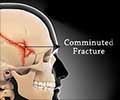A technique developed by Johns Hopkins surgeons is providing a new route to get to and remove tumors buried at the base of the skull: through the natural hole behind the molars, above

Kofi Boahene, M.D., an assistant professor of facial plastic and reconstructive surgery and otolaryngology–head and neck surgery at the Johns Hopkins University School of Medicine, says the idea for the new approach came to him when a 20-year-old female patient previously treated for a brain tumor developed a new tumor deep in the skull base.
Traditional surgeries to remove skull base tumors require incisions through the face and bone removal, which can sometimes be disfiguring. Additionally, these operations can harm facial nerves, leading to paralysis that affects facial expressions and days or weeks of hospitalization and recovery. Boahene said he was gazing at a skull model in his office, considering options to spare his patient from another traditional surgery. "I looked at the 'window" that already exists in the skull, above the jawbone and below the cheekbone and realized this was an access route not previously recognized for this kind of surgery," he said.
Knowing there was always the option of switching to the traditional approach while trying the new approach, Boahene and his colleagues performed the new procedure on his patient last year. The expected surgery time shrunk from six hours to two. Additionally, the patient was able to leave the hospital the next day and return to college, with no visible evidence that she had surgery performed.The report in the Laryngoscope describes details of the surgeries on three of the seven patients Boahene and his colleagues have thus far treated. Besides benefits for patients, he and his colleagues note, the new procedure is significantly less complicated for surgeons to perform, provides excellent visualization of the skull base area, and could potentially save health care dollars due to patients' shorter hospital stays.
Not all patients are candidates for this procedure, Boahene cautions. It isn't an option for those with very large skull base tumors or those with tumors that wrap around blood vessels. For these patients, traditional skull base surgery is still the best choice, he says.
In the future, he and his colleagues plan to try the new procedure using a surgical robot, which could provide even better visualization for surgeons and further reduce chances of complications for patients.
Advertisement
Source-Eurekalert










